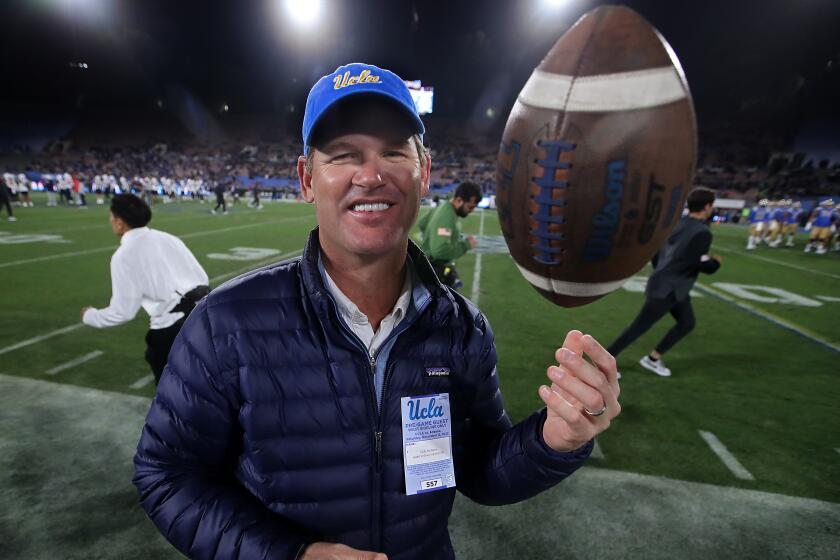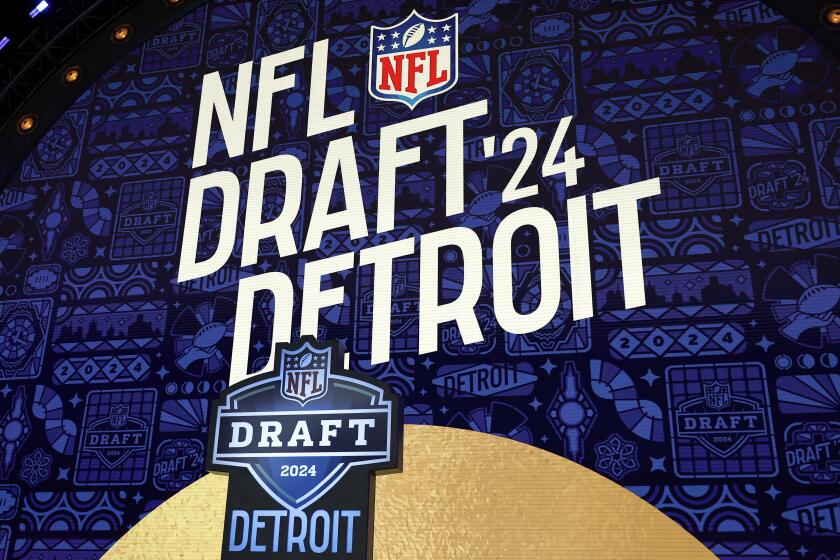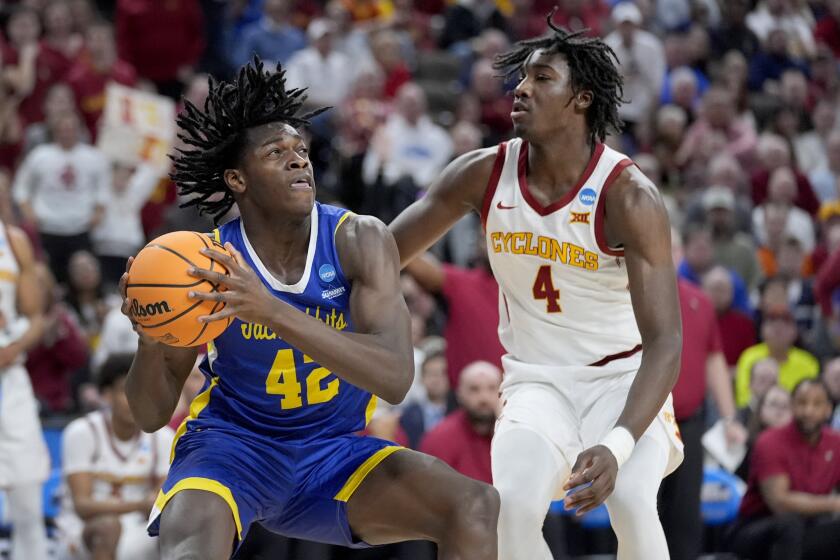INSIDE AND OUTSIZED
Before the University of Houston’s first appearance in an NCAA Final Four in 1967, its players were sitting in a hotel ballroom in Louisville, Ky., when they found themselves in the middle of a chaotic scene.
Camera lights flashed, reporters shouted questions and fans begged for autographs as college basketball’s greatest player, Lew Alcindor, hidden behind dark glasses, and the rest of the UCLA team entered the room like so many rock stars.
“Do they have to pay these guys?” Houston guard Don Chaney remembers thinking of the Bruins’ entourage. “We felt like country bumpkins.”
UCLA easily defeated Houston the next day, 73-58, en route to a 30-0 season and the third of its 10 national championships under John Wooden. One Cougars player was unimpressed, however.
“He was OK, but I think he’s a little overrated,” Elvin Hayes said of Alcindor, who dominated him in the game. “We’ll definitely beat them when we play them down in Texas.”
It was Houston Coach Guy Lewis who first proposed having his team play UCLA in the Astrodome, and at first he seemed to be the only one who thought it was a good idea. College basketball was still a regional game -- as recently as half a dozen years earlier, the NCAA championships hadn’t been shown live on national television -- and Houston was hardly a basketball town. The Cougars didn’t even have their own arena, playing their games in an off-campus gym that held only 2,500 people.
But Lewis wore down the resistance of Houston Athletic Director Harry Fouke by offering to pay both schools $10,000 out of his own pocket. “Harry knew I couldn’t raise $10,000,” Lewis said. “I probably couldn’t have raised $500, but he said, ‘Dammit, if you believe in it that much let’s talk about it.’ ”
Wooden was against the game too. Play basketball in a baseball stadium? In the middle of the conference season? At night? It would be a farce.
But Wooden was overruled by the one man at UCLA able to do so, Athletic Director J.D. Morgan.
The game would spread the appeal of college basketball nationally, Morgan believed. It would be good for the game and UCLA, its preeminent team, should be a part of it.
Judge Roy Hofheinz, who had built the Astrodome, was skeptical too. The arena had been designed for baseball and football, and although Hofheinz had promoted boxing matches, stock car races and even a bullfight, he thought a basketball court would be too far from the stands for the fans to be able to see.
“But you have this little ball in baseball,” Lewis argued. “Don’t you think people could see our big one? And besides, most of the players on my team are bigger than the ones on your baseball team.”
“Well, damn if you’re not right,” Hofheinz said, laughing.
The game was set for Jan. 20, 1968, 40 years ago today. The big question now was whether anyone around the country would see it. None of the three major networks wanted to televise it and an attempt to bring in an independent network failed.
Finally, Eddie Einhorn, who televised college basketball regionally on his TSN network, stepped in. Einhorn traveled the country and visited one station at a time as he tried to overcome resistance to this radical innovation -- a college basketball game broadcast nationally in prime time.
Some station directors saw the game’s potential and signed up early. “I don’t care if anyone else wants to see it,” one of them told Einhorn. “Hell, I want to see it.” But others resisted until the momentum started to build and they found themselves competing with other stations in their areas.
In the end, Einhorn signed up 120 stations, many of which would infuriate the networks they were affiliated with by canceling their regular programming to show the game.
With no secretarial staff, Lewis and an assistant sold tickets from their small office. “We would take turns answering the phone, which was sitting on my desk between us,” Lewis says. “He would pick up one call and I’d get the next until one of us got tired and walked out of the office.”
To help publicize the game, Houston publicity director Ted Nance placed a life-size cutout of Alcindor’s head at his exact height -- 7 feet 2 -- above the floor in his office (“I might have cheated a little,” Nance says), hoping to persuade sportswriters in town for football to return in January.
But the best promotion of all came from the two teams, which both went through the opening part of the season undefeated, forcing fans around the country, and non-fans intrigued by the promise of a spectacle, to take notice.
About the only ones who remained unimpressed were UCLA’s players, a number of whom had never lost a college game, and Wooden worked hard to keep it that way. It’s just another game, he told them, not as important as the conference season or the national tournament.
The Cougars, by contrast, could hardly wait. They eagerly checked the scores of UCLA’s games, hoping the Bruins had won. They wanted to be the ones to break the team’s winning streak, which, as UCLA arrived in Houston, had reached 47 games.
The Astrodome was in a frenzy. The capacity crowd jamming the arena was joined by more reporters than attended the NCAA championships.
Along with UCLA’s young broadcaster Dick Enberg, the writers were seated in a trench near the floor, which had been trucked in from the Los Angeles Sports Arena, so they wouldn’t obstruct the view of fans many yards away. Sitting next to Enberg, Einhorn continued to field calls from advertisers and even during the game passed along hand-written notes. “His writing wasn’t all that good, either,” Enberg says.
After warming up, UCLA returned to its locker room and remained until after the national anthem was played. Bruins forward Lynn Shackelford remembers Wooden being concerned that Alcindor, who was becoming involved in racial politics and would later change his name to Kareem Abdul-Jabbar, might create a controversy by not standing for the anthem.
But the coach also had a more pressing concern about his best player: Alcindor’s left eye had been scratched in a game against California a week earlier and was now covered by a large white bandage.
The Houston players were nervous too, as was Nance, who, shortly before the game began, wandered under the stands to an area used as a press lunchroom. There he saw two large rats -- no strangers to the Astrodome, which was located in the middle of an empty field -- gnawing on some leftovers. Thankful no reporters were there to witness the scene, Nance threw salt and pepper shakers to shoo them away.
Coming out onto the floor, the players were stunned by the size and the noise of the crowd of more than 52,000 people, the most ever to see a basketball game in the United States. “Slow down,” Lewis told his players. “I want to enjoy this.”
As people stood for the national anthem, Einhorn shouted orders to wait; he still had a few more commercials to show. The puzzled crowd stood for two minutes before the music was played.
Almost immediately, it became clear the game would be worthy of the buildup.
Houston started fast, led by Hayes, who consistently beat Alcindor down the court and, scoring on open jump shots and layups, had 25 points in the first half.
Sensing an upset by the hometown team, the crowd screamed so loudly that Chaney said later it was the only time he ever played basketball and couldn’t hear the ball bounce.
UCLA was hampered by Alcindor’s lack of conditioning even more than his eye injury -- “I was winded and out of shape after missing two games,” he remembered -- but the long-range shooting of guard Lucius Allen kept the Bruins from falling far behind. Houston led at halftime, 46-43.
As Houston maintained its lead in the second half, UCLA’s players grew so desperate they began to think the unthinkable. “We can’t run because of Lew,” guard Mike Warren told Shackelford. “We have to wait for him. Maybe I should go to Coach and ask if we should take him out.”
“Take the greatest player of all time out of the game?” Shackelford said. “You can’t do that. Don’t even think it.” Despite shooting only four for 18 from the floor, Alcindor played the entire game. Still, the Bruins tied the score three times until, with 28 seconds left and the score 69-69, Hayes, who finished with 39 points, made two free throws.
UCLA got the ball one last time but a pass was intercepted and, with 12 seconds left, the ball came to Hayes, who dribbled dangerously down the court. “Why do you have the ball?” he asked himself. “Someone could steal it. Pass it.”
But he continued dribbling until, just before the buzzer, he passed to a teammate who threw the ball high in the air.
As the Houston fans leaped over the trench at the side of the field and ran toward the court (“It was like the charge at the Alamo,” Enberg says), the game that showed how television was about to change college basketball forever ended with Houston winning, 71-69.
Postscript: It took UCLA only two months to avenge its historic loss. Playing in the semifinals of the NCAA tournament in the Sports Arena, on the same floor that had been used in Houston, the Bruins beat the Cougars, 101-69, and went on to win another national title.
The television audience for the rematch was barely half that of the game in the Astrodome.
--
This article is based on interviews contained in “How March Became Madness: How the NCAA Basketball Tournament Became the Greatest Sporting Event in America,” by Eddie Einhorn with Ron Rapoport.
Go beyond the scoreboard
Get the latest on L.A.'s teams in the daily Sports Report newsletter.
You may occasionally receive promotional content from the Los Angeles Times.



